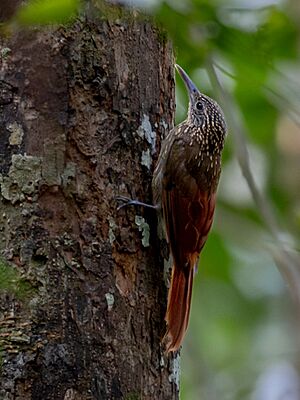Chestnut-rumped woodcreeper facts for kids
Quick facts for kids Chestnut-rumped woodcreeper |
|
|---|---|
 |
|
| at Presidente Figueiredo, Amazonas state, Brazil | |
| Conservation status | |
| Scientific classification | |
| Genus: |
Xiphorhynchus
|
| Species: |
pardalotus
|
 |
|
The chestnut-rumped woodcreeper (Xiphorhynchus pardalotus) is a cool bird found in parts of South America. It lives in countries like Brazil, French Guiana, Guyana, Suriname, and Venezuela. This bird is part of the ovenbird family, which is known for its unique nests.
Contents
About the Chestnut-Rumped Woodcreeper
Scientists give animals special names to help identify them. The chestnut-rumped woodcreeper has two main types, called subspecies. These are X. p. pardalotus and X. p. caurensis. They are very similar but have small differences.
What Does This Bird Look Like?
The chestnut-rumped woodcreeper is a medium-sized bird. It has a long, thin beak that curves slightly downwards. These birds are about 20 to 23.5 centimeters (8 to 9 inches) long. Males usually weigh between 32 and 49 grams, while females are a bit lighter, weighing 27 to 46 grams.
Both male and female birds look alike. Their faces have thin, light brown and dark brown stripes. They have a light buff stripe above their eyes. The top of their head and neck are dark brownish-black with light spots. These spots turn into streaks on their neck.
Their back and wing feathers are reddish-brown to olive-brown. They also have some pale streaks with dark edges. Their wings, rump (the lower back), and tail are a bright reddish-chestnut color. The tips of their main wing feathers are darker.
Their throat is a yellowish-brown color, and their chest and sides are olive-brown. These areas have cinnamon-buff streaks with dark edges. Their lower belly is more reddish and has brownish spots. Their eyes are dark brown. Their upper beak is dark brown or black, and their lower beak is light gray. Their legs and feet are bluish-gray. Young birds have a shorter beak and less strong dark borders on their streaks.
The X. p. caurensis subspecies has more reddish upper parts and less noticeable streaks than the other subspecies.
Where Do They Live?
The chestnut-rumped woodcreeper lives in different areas. The X. p. pardalotus subspecies is found in the Guianas and northern Brazil. This area is north of the Amazon River, between the Rio Negro and the Atlantic Ocean.
The X. p. caurensis subspecies lives further west. It is found in the tepui region, where Venezuela, Guyana, and Brazil meet. Tepuis are special flat-topped mountains. Some people think this bird might live even further west in Colombia, but there is no proof yet.
These birds mostly live in lowland evergreen forests. They also live in lower parts of mountain forests in the tepui region. They prefer the inside of old, untouched forests. However, they can also be found at the edges of these forests and in older secondary forests (forests that have grown back after being cut down). Sometimes, they live in forests near rivers or in wooded savannas. They usually live below 500 meters (1,600 feet) in elevation. But on the tepuis, they can be found as high as 1,800 meters (5,900 feet).
How They Live Their Lives
Staying in One Place
The chestnut-rumped woodcreeper does not migrate. It stays in the same area all year round.
What Do They Eat?
These birds mainly eat arthropods, which are like insects and spiders. You can often see single birds or pairs joining groups of different bird species that hunt together. They especially like to join flocks led by Thamnomanes antshrikes.
When hunting, they climb up and along tree trunks and branches. They search for food from the lower parts of the forest all the way up to the treetops. They find their prey by picking it off surfaces or by poking into cracks in bark. They also search in clumps of dead leaves, plants growing on other plants (epiphytes), and dead wood.
Sometimes, they follow swarms of army ants. These ants stir up insects and other small creatures as they move. The woodcreepers then catch the prey that the ants disturb. When following ants, they usually stay close to the ground, within about 5 meters (16 feet).
How They Raise Their Young
The chestnut-rumped woodcreeper usually breeds during the dry season, from September to January. They make their nests in natural holes in trees or stumps. They add bark chips inside the cavity to make it cozy. So far, scientists have only found nests with one egg. We don't know how long it takes for the eggs to hatch or for the young birds to leave the nest. Both parents help feed the baby birds.
What Do They Sound Like?
The chestnut-rumped woodcreeper sings mostly at dawn and dusk. Their song sounds like "chip!, chip, chip, chi-i-i-i-i-i-i-ip" or "zut, zut, zut-zut-zut-t’t’t’t’t,e’e e". Their calls are a mix of chirps, like "ik" and "chip".
Is This Bird Safe?
The IUCN (International Union for Conservation of Nature) says the chestnut-rumped woodcreeper is a species of "Least Concern." This means they are not currently in danger of disappearing. They live across a large area, and even though we don't know their exact numbers, their population seems stable. There are no immediate threats to them.
These birds are quite common in the lowlands. However, like many birds that live in flocks or follow ants, they are sensitive to losing their forest homes. When forests are cut down or broken into smaller pieces, it can be hard for these birds to survive. Protecting their forest habitat is important for their future.


